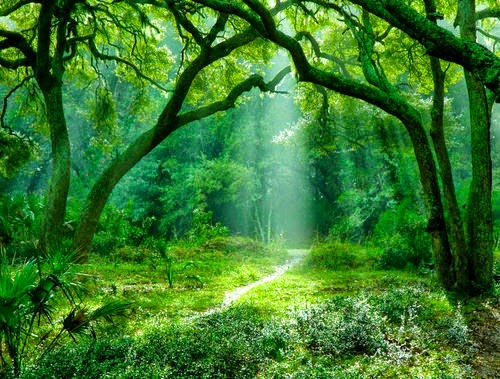The Sidhe
In many Gaelic tales the aos sí are later, literary versions of the Tuatha Dé Danann ("People of the Goddess Danu") – the deities and deified ancestors of Irish mythology. Some sources describe them as the survivors of the Tuatha Dé Danann who retreated into the Otherworld after they were defeated by the Milesians – the mortal Sons of Míl Espáine who, like many other early invaders of Ireland, came from Iberia. Geoffrey Keating, an Irish historian of the late 17th century, equates Iberia with the Land of the Dead.
In folk belief and practice, the aos sí are often appeased with offerings, and care is taken to avoid angering or insulting them. Often they are not named directly, but rather spoken of as "The Good Neighbors", "The Fair Folk", or simply "The Folk". The most common names for them, aos sí, aes sídhe, daoine sídhe (singular duine sídhe) and daoine sìth mean, literally, "people of the mounds" (referring to the sidhe). The aos sí are generally described as stunningly beautiful, though they can also be terrible and hideous.
Aos sí are sometimes seen as fierce guardians of their abodes – whether a fairy hill, a fairy ring, a special tree (often a hawthorn) or a particular loch or wood. The Gaelic Otherworld is seen as closer at the times of dusk and dawn, therefore this is a special time to the aos sí, as are some festivals such as Samhain, Beltane and Midsummer.
The sídhe: abodes of the aes sídhe
As part of the terms of their surrender to the Milesians the Tuatha Dé Danann agreed to retreat and dwell underground in the sídhe (modern Irish: sí; Scottish Gaelic: sìth; Old Irish síde, singular síd), the hills or earthen mounds that dot the Irish landscape. In some later poetry each tribe of the Tuatha Dé Danann was given its own mound.
In a number of later English language texts the word sídhe is used both for the mounds and the people of the mounds. However sidh in older texts refers specifically to "the palaces, courts, halls or residences" of the ghostly beings that, according to Gaedhelic mythology, inhabit them.
The fact that many of these sídhe have been found to be ancient burial mounds has contributed to the theory that the aos sí were the pre-Celtic occupants of Ireland. "The Book of Invasions", "The Annals of the Four Masters", and oral history support this view.
Others present these stories as mythology deriving from Greek cultural influence, deriving arguments mainly from Hesiod's "Works and Days", which portrays the basic moral foundation and plantation techniques of the citizens of Greece and describes the races of men, created by the Greek deities. However, these views have been deemed unlikely, and the so-called influence can be reasonably explained by the similar moral foundations stemming from the two cultures' Indo-European background.
The story of the Aes Sídhe is found all over Scotland and Ireland, many tales referring to how the Norse invaders drove Scottish inhabitants underground to live in the hills. This part of the legend contributes to the Changeling myth in west European folklore.
Leanan sídhe: the "fairy lover"
The Cat Sìth: a fairy cat; and the Cù Sìth: fairy dog.
The sluagh sídhe — "the fairy host" — is sometimes depicted in Irish and Scottish lore as a crowd of airborne spirits, perhaps the cursed, evil or restless dead. The siabhra (anglicised as "sheevra"), may be a type of these lesser spirits, prone to evil and mischief. However an Ulster folk song also uses "sheevra" simply to mean "spirit" or "fairy".
Source: Here
love and light
Trace
xoxo









No comments:
Post a Comment